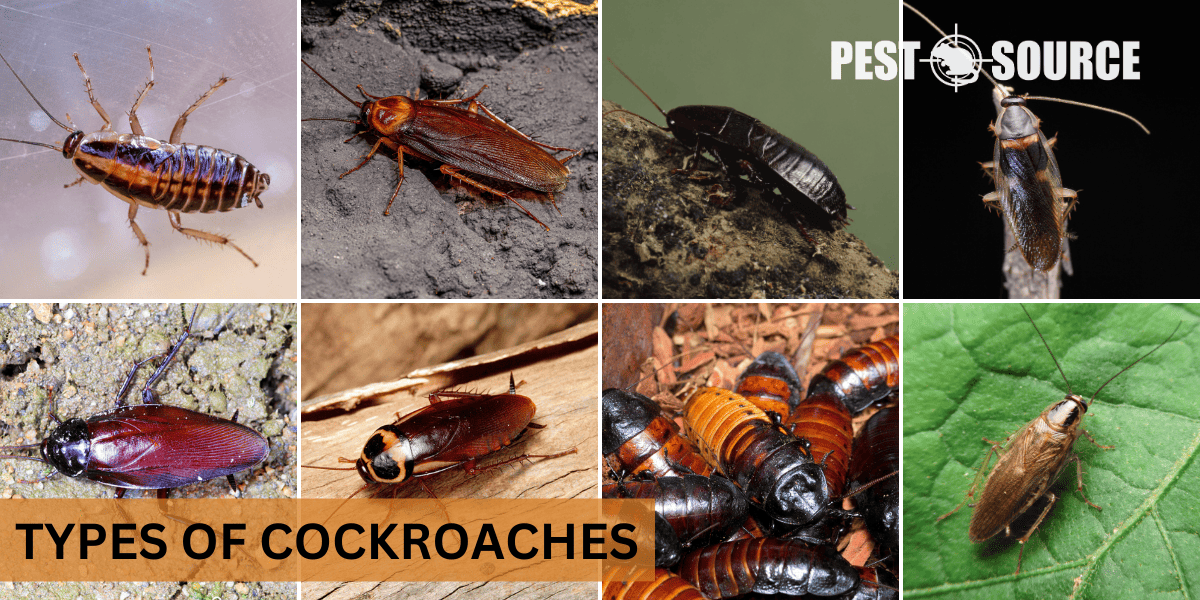There are several types of cockroaches, each with unique characteristics and habitats. This article provides an overview of the most common species, aiding in identification and tailored control measures.
POINTS
- Cockroaches have a diverse range of over 4,500 identified species, with specific adaptations that have allowed them to survive for hundreds of millions of years across various environments.
- Common household cockroach species like the German and American cockroaches have unique identifying features and behaviors, necessitating tailored pest control strategies for effective management.
- Misconceptions about cockroach behavior, such as their purported ability to survive nuclear fallout, can impede proper pest control practices; understanding true cockroach capabilities is crucial.
- Integrated Pest Management (IPM) approaches, which combine sanitation, exclusion, and chemical treatments, are essential for controlling cockroach populations effectively.
- Regional variations in cockroach species and environmental factors like climate and food sources play a significant role in the distribution of cockroaches and the challenges associated with controlling them.
Types of Cockroaches: Overview and Identification
Cockroaches are one of the most adaptable and persistent pests that can invade our homes. With thousands of species globally, only a handful are common in human habitats. These insects are not just a nuisance but also pose health risks by spreading germs and triggering allergies. Understanding the various types of cockroaches is crucial for effective pest control. Let’s delve into the characteristics and behaviors of some of the most prevalent species.
German Cockroach (Blattella germanica)

The German cockroach, Blattella germanica, is a pervasive pest found predominantly in human dwellings such as apartments, restaurants, and other facilities. These insects are easily recognized by their light brown color and two dark stripes on their pronotum. Despite having wings, German cockroaches rarely take flight and are more likely to scurry away when threatened. They favor warm, moist environments, which makes residential kitchens and bathrooms ideal for their survival.
One of the most daunting aspects of controlling German cockroaches is their remarkable reproductive capacity. A single female can produce numerous egg cases during her lifespan, each containing up to 40 eggs. This rapid reproduction, coupled with their notorious ability to develop resistance to pesticides, presents a significant challenge in managing their populations. Effective control typically involves a multifaceted approach that includes strict sanitation measures, targeted bait applications, and, in some cases, professional pest control services to ensure complete eradication.
American Cockroach (Periplaneta americana)

The American cockroach, Periplaneta americana, is one of the largest species of common cockroaches, reaching lengths of up to 4 cm (1.6 inches). Boasting a reddish-brown hue, these insects are equipped with a pair of long, membranous wings, which allow them to fly short distances, although they are more often seen running. Their preference for warm and humid conditions leads them to inhabit places such as sewers, basements, and steam tunnels in urban environments. Despite their name, they are not native to North America but are believed to have originated in Africa or the Middle East.
American cockroaches are nocturnal creatures that emerge at night to feed on a wide variety of food sources, including decaying organic matter, sweets, grease, and even book bindings. They can survive for several months without food and up to one month without water, contributing to their resilience as a species. Their presence can be more than just a nuisance, as they are known to carry pathogens on their bodies that can contaminate food and surfaces, potentially leading to allergic reactions and asthma in sensitive individuals. Controlling and preventing infestations typically involve environmental management, such as reducing moisture and access to food, along with chemical treatments when necessary.
Oriental Cockroach (Blatta orientalis)

The Oriental cockroach, Blatta orientalis, is a robust species often referred to as “water bugs” due to their preference for dark and damp environments. They exhibit a distinctive glossy, dark brown to black exoskeleton and are known for their particularly sluggish movement compared to other cockroach species. Adult Oriental cockroaches typically range in size from 18 to 29 mm (about 0.7 to 1.1 inches) for females and are slightly smaller for males. The females have small, functionless wing pads, while males have longer wings that cover about three-quarters of their abdomen, yet neither sex is capable of flight.
These insects are most commonly found in cooler, moist areas such as basements, drains, crawl spaces, and areas around pipes and leaks. Oriental cockroaches are scavengers and will feed on a wide variety of organic matter, with a particular penchant for decaying material. Their tendency to feed on filth means they can spread various bacteria and pathogens, which poses a risk of contaminating food and surfaces in human habitats. Controlling Oriental cockroach infestations often requires reducing moisture levels, sealing entry points to buildings, and employing baits, traps, or chemical treatments as necessary to target the existing population.
Brown-Banded Cockroach (Supella longipalpa)

The Brown-banded cockroach, Supella longipalpa, is a relatively small species of cockroach, with adults typically ranging from 11 to 14.5 mm in length. They are easily identifiable by the two lighter brown bands that cross their dark brown bodies horizontally, which are more pronounced across their wings. These bands are present in both males and females, although males have more slender bodies and longer wings that extend beyond their abdomen, enabling them to fly short distances. In contrast, females have shorter wings and a broader, more rounded body.
Unlike other common cockroach species that prefer moist environments, brown-banded cockroaches are attracted to warmer and drier locations. They are often found in upper cabinets, closets, and even behind picture frames, but they are particularly drawn to the heat generated by electrical appliances such as refrigerator motors, televisions, and clocks. Their preference for dry habitats means they can be found throughout an infested home. Effective management of brown-banded cockroach infestations involves thorough inspections, removal of harborage sites, and treatment with insecticides specifically formulated for this species. Heat treatments can also be effective, given their intolerance for high temperatures.
Smokybrown Cockroach (Periplaneta fuliginosa)

The Smokybrown cockroach, Periplaneta fuliginosa, is a large species of cockroach, with adults reaching lengths of about 3 to 3.5 cm (1.2 to 1.4 inches). Their uniform dark mahogany or smokey brown coloration makes them easily distinguishable from other cockroach species. These cockroaches are strong fliers, which contributes to their ability to move from one location to another, and they are particularly active at night. The smokybrown cockroach’s preference for high humidity is so pronounced that they can quickly dehydrate in environments that do not meet their moisture requirements.
Typically found in warm, humid climates, the smokybrown cockroach is a common outdoor pest, often inhabiting areas such as tree holes, mulch, and under roof shingles or behind gutters. However, they are known to venture indoors in search of food and water, especially during dry periods. Indoors, they can be found in attics, crawl spaces, and other areas where humidity levels are higher. To prevent and control infestations, it is crucial to eliminate sources of moisture and food, seal entry points, and remove yard debris that may serve as harborage. Chemical treatments may be necessary for established infestations, often including baits, residual sprays, and dust formulations applied to their hiding places.
Australian Cockroach (Periplaneta australasiae)

The Australian cockroach, Periplaneta australasiae, is a species that bears a close resemblance to the American cockroach but can be identified by its slightly smaller size, typically around 30 to 35 mm (1.2 to 1.4 inches) in length. A distinguishing feature of the Australian cockroach is the striking yellow markings on the edge of its thorax and the yellow streaks on the sides of its wings, which set it apart from its American counterpart. These cockroaches are adept at flying, which allows them to move quickly from one location to another, and they are most active during the night.
Favoring warm and humid environments, the Australian cockroach is commonly found both indoors and outdoors in regions with mild climates. They are particularly prevalent in greenhouses and garden areas where they feed on plant material, but they can also be found in homes and commercial buildings, where they feed on a variety of organic matter, including food scraps and book bindings. Controlling the Australian cockroach involves maintaining clean living spaces, reducing moisture and potential food sources, and sealing entry points to prevent their ingress. Chemical control measures may include the use of baits, insecticidal dust, and residual sprays applied to areas where these cockroaches are likely to hide or enter.
Madagascar Hissing Cockroach (Gromphadorhina portentosa)

The Madagascar hissing cockroach, Gromphadorhina portentosa, is one of the largest cockroach species, with adults reaching lengths of 5 to 7.5 cm (2 to 3 inches). This species is wingless and features a hard exoskeleton with a brown to black coloration. Native to the island of Madagascar, these cockroaches have a unique ability to produce a hissing sound, which they achieve by expelling air through the spiracles, small openings located on their abdomen. This hissing noise is used for communication during mating rituals, territorial disputes, and as a defense mechanism when threatened.
Unlike many other cockroach species, Madagascar hissing cockroaches are not considered pests and do not invade human habitats. They are primarily found on the forest floor of their native Madagascar, where they play a vital role in the ecosystem by consuming decaying plant material and aiding in nutrient recycling. Due to their docile nature and ease of care, Madagascar hissing cockroaches have become popular as exotic pets, often kept in terrariums where they can be provided with a diet of fruits, vegetables, and pellets. Their lack of wings, inability to climb smooth surfaces, and absence of the typical pest-like behavior make them suitable for captivity. However, it is important to note that they still require a controlled environment that mimics their natural habitat to thrive.
Asian Cockroach (Blattella asahinai)

The Asian cockroach, Blattella asahinai, is often mistaken for the German cockroach due to their strikingly similar appearance. Both species are relatively small, with the Asian cockroach measuring about 13 to 16 mm in length, and share the characteristic light brown coloration with two parallel dark stripes on their pronotum. However, the Asian cockroach sets itself apart with its strong flying ability, which distinguishes it from its flightless German counterpart. This ability to fly not only aids in their distribution but also makes them more likely to enter homes and other structures.
Primarily an outdoor species, the Asian cockroach is drawn to light, making it a common visitor to porches and windows in the evening. While they are not typically an indoor pest, their attraction to light can lead them inside buildings, where they may be found flying towards illuminated surfaces. Unlike some other cockroach species, the Asian cockroach is more commonly found in grassy areas and landscaped environments, where they feed on decaying organic matter. Managing infestations of Asian cockroaches involves reducing outdoor lighting or using lights that are less attractive to insects, sealing entry points to prevent indoor migration, and maintaining a clean environment to discourage them from settling. Pest control treatments may include the use of baits and residual insecticides applied to outdoor harborage areas.
When identifying cockroach species, it’s essential to note their size, color, and habitat preferences. Household cockroaches like the German and American species often cause confusion due to their similar appearances. Misconceptions also arise with terms like “roaches” and “cockroaches,” which are used interchangeably, though “cockroach” is the correct entomological term.
Household and Regional Cockroach Varieties
Common Household Cockroach Species
Among the household invaders, the German and American cockroaches are the most prevalent. German cockroaches can be identified by their small size and light brown color, while American cockroaches are larger and reddish-brown. Both species seek out food, water, and warmth, which often leads them into our homes.
Regional Variations in Cockroach Species
The American cockroach, despite its name, is found worldwide, but certain species are more common in specific regions. For example, the smokybrown cockroach is often encountered in the southeastern United States due to the warm, humid climate.
Attractants and Distribution
Cockroaches are attracted to homes by the availability of food, water, and shelter. They can hitchhike in boxes, grocery bags, or through plumbing and electrical connections. Their distribution is influenced by climate and geographical factors, with different species preferring varying environmental conditions.
Understanding the types of cockroaches that may invade your space is the first step in effective pest control. Each species has its unique characteristics and requires a tailored approach to manage.
Species Diversity, Evolution, and Ecological Impact
Cockroaches have been on Earth for hundreds of millions of years, showcasing an incredible capacity for survival and adaptation. Their diversity is a testament to their evolutionary success, with over 4,500 species identified worldwide. These insects have adapted to a variety of ecological roles, from forest floor recyclers to unwelcome urban dwellers.
Evolutionary Background of Cockroaches
Cockroaches originated during the Carboniferous period, making them one of the oldest groups of insects. This long evolutionary history has allowed them to develop sophisticated survival strategies, from nocturnal behavior to the ability to withstand harsh environments. Their resilience is further evidenced by their diverse range of habitats, from tropical forests to arid deserts.
Global Cockroach Species Diversity
Although only a small fraction of cockroach species are considered pests, the global number of species is estimated to be vast. Many of these species play crucial ecological roles, such as decomposing organic matter and being a food source for other animals. This diversity reflects their ability to adapt to a wide range of environmental conditions.
Unique Characteristics and Adaptations
Some species of cockroaches have evolved unique characteristics, such as the yellow stripes of the Australian cockroach or the hissing abilities of the Madagascar hissing cockroach. These adaptations can be attributed to their specific ecological niches or survival mechanisms, such as deterring predators or attracting mates.
Pest Control Strategies and Misconceptions
Effective pest control is essential for maintaining a healthy living environment, but it requires an understanding of the specific habits and vulnerabilities of different cockroach species. Let’s explore some of the strategies and common misconceptions regarding cockroach pest control.
Control Methods for Household Cockroach Species
Each cockroach species responds differently to various control methods. For example, German cockroaches may require baiting techniques and insect growth regulators, while American cockroaches might be managed with perimeter treatments and exclusion practices. Integrated Pest Management (IPM) is a holistic approach that combines sanitation, exclusion, and chemical treatments to effectively control cockroach populations.
Clarifying Cockroach Misconceptions
There are many misconceptions about cockroach behavior and lifespan that can hinder effective pest control. For instance, the belief that cockroaches can survive a nuclear explosion is exaggerated, although they are more resistant to radiation than humans. Understanding the actual capabilities and limitations of cockroaches is crucial for proper pest management.
Challenges in Cockroach Management
Different cockroach species present unique challenges in pest management. Factors such as resistance to pesticides, reproductive rates, and environmental preferences must be considered. Additionally, regional differences, such as climate and available food sources, can impact the effectiveness of control measures.



